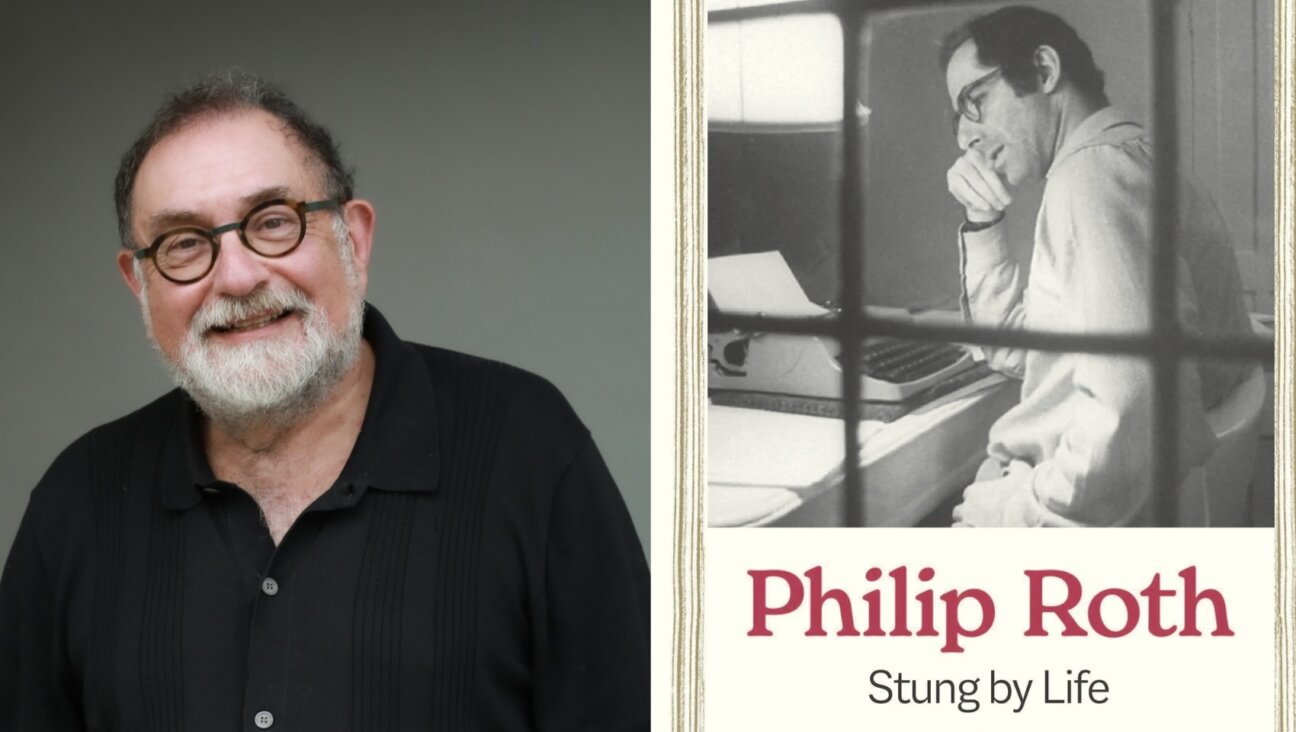‘Jews a Race’ Genetic Theory Comes Under Fierce Attack by DNA Expert

Articles by Eran Elhaik, a researcher at the University of Sheffield, were debunked by an international group of thirty geneticists. Image by Rita Rubin
Sign up for Forwarding the News, our essential morning briefing with trusted, nonpartisan news and analysis, curated by Senior Writer Benyamin Cohen.
Scientists usually don’t call each other “liars” and “frauds.”
But that’s how Johns Hopkins University post-doctoral researcher Eran Elhaik describes a group of widely respected geneticists, including Harry Ostrer, professor of pathology and genetics at Yeshiva University’s Albert Einstein College of Medicine and author of the 2012 book “Legacy: A Genetic History of the Jewish People.”
For years now, the findings of Ostrer and several other scientists have stood virtually unchallenged on the genetics of Jews and the story they tell of the common Middle East origins shared by many Jewish populations worldwide. Jews — and Ashkenazim in particular — are indeed one people, Ostrer’s research finds.
It’s a theory that more or less affirms the understanding that many Jews themselves hold of who they are in the world: a people who, though scattered, share an ethnic-racial bond rooted in their common ancestral descent from the indigenous Jews of ancient Judea or Palestine, as the Romans called it after they conquered the Jewish homeland.
But now, Elhaik, an Israeli molecular geneticist, has published research that he says debunks this claim. And that has set off a predictable clash.
“He’s just wrong,” said Marcus Feldman of Stanford University, a leading researcher in Jewish genetics, referring to Elhaik.
The sometimes strong emotions generated by this scientific dispute stem from a politically loaded question that scientists and others have pondered for decades: Where in the world did Ashkenazi Jews come from?
The debate touches upon such sensitive issues as whether the Jewish people is a race or a religion, and whether Jews or Palestinians are descended from the original inhabitants of what is now the State of Israel.
Ostrer’s theory is sometimes marshaled to lend the authority of science to the Zionist narrative, which views the migration of modern-day Jews to what is now Israel, and their rule over that land, as a simple act of repossession by the descendants of the land’s original residents. Ostrer declined to be interviewed for this story. But in his writings, Ostrer points out the dangers of such reductionism; some of the same genetic markers common among Jews, he finds, can be found in Palestinians, as well.
By using sophisticated molecular tools, Feldman, Ostrer and most other scientists in the field have found that Jews are genetically homogeneous. No matter where they live, these scientists say, Jews are genetically more similar to each other than to their non-Jewish neighbors, and they have a shared Middle Eastern ancestry.
The geneticists’ research backs up what is known as the Rhineland Hypothesis. According to the hypothesis, Ashkenazi Jews descended from Jews who fled Palestine after the Muslim conquest in the seventh century and settled in Southern Europe. In the late Middle Ages they moved into eastern Europe from Germany, or the Rhineland.
“Nonsense,” said Elhaik, a 33-year-old Israeli Jew from Beersheba who earned a doctorate in molecular evolution from the University of Houston. The son of an Italian man and Iranian woman who met in Israel, Elhaik, a dark-haired, compact man, sat down recently for an interview in his bare, narrow cubicle of an office at Hopkins, where he’s worked for four years.
In “The Missing Link of Jewish European Ancestry: Contrasting the Rhineland and the Khazarian Hypotheses,” published in December in the online journal Genome Biology and Evolution, Elhaik says he has proved that Ashkenazi Jews’ roots lie in the Caucasus — a region at the border of Europe and Asia that lies between the Black and Caspian seas — not in the Middle East. They are descendants, he argues, of the Khazars, a Turkic people who lived in one of the largest medieval states in Eurasia and then migrated to Eastern Europe in the 12th and 13th centuries. Ashkenazi genes, Elhaik added, are far more heterogeneous than Ostrer and other proponents of the Rhineland Hypothesis believe. Elhaik did find a Middle Eastern genetic marker in DNA from Jews, but, he says, it could be from Iran, not ancient Judea.
Elhaik writes that the Khazars converted to Judaism in the eighth century, although many historians believe that only royalty and some members of the aristocracy converted. But widespread conversion by the Khazars is the only way to explain the ballooning of the European Jewish population to 8 million at the beginning of the 20th century from its tiny base in the Middle Ages, Elhaik says.
Elhaik bases his conclusion on an analysis of genetic data published by a team of researchers led by Doron Behar, a population geneticist and senior physician at Israel’s Rambam Medical Center, in Haifa. Using the same data, Behar’s team published in 2010 a paper concluding that most contemporary Jews around the world and some non-Jewish populations from the Levant, or Eastern Mediterranean, are closely related.
Elhaik used some of the same statistical tests as Behar and others, but he chose different comparisons. Elhaik compared “genetic signatures” found in Jewish populations with those of modern-day Armenians and Georgians, which he uses as a stand-in for the long-extinct Khazarians because they live in the same area as the medieval state.
“It’s an unrealistic premise,” said University of Arizona geneticist Michael Hammer, one of Behar’s co-authors, of Elhaik’s paper. Hammer notes that Armenians have Middle Eastern roots, which, he says, is why they appeared to be genetically related to Ashkenazi Jews in Elhaik’s study.
Hammer, who also co-wrote the first paper that showed modern-day Kohanim are descended from a single male ancestor, calls Elhaik and other Khazarian Hypothesis proponents “outlier folks… who have a minority view that’s not supported scientifically. I think the arguments they make are pretty weak and stretching what we know.”
Feldman, director of Stanford’s Morrison Institute for Population and Resource Studies, echoes Hammer. “If you take all of the careful genetic population analysis that has been done over the last 15 years… there’s no doubt about the common Middle Eastern origin,” he said. He added that Elhaik’s paper “is sort of a one-off.”
Elhaik’s statistical analysis would not pass muster with most contemporary scholars, Feldman said: “He appears to be applying the statistics in a way that gives him different results from what everybody else has obtained from essentially similar data.”
Elhaik, who doesn’t believe that Moses, Aaron or the 12 Tribes of Israel ever existed, shrugs off such criticism.
“That’s a circular argument,” he said of the notion that Jews’ and Armenians’ genetic similarities stem from common ancestors in the Middle East and not from Khazaria, the area where the Armenians live. If you believe that, he says, then other non-Jewish populations, such as Georgian, that are genetically similar to Armenians should be considered genetically related to Jews, too, “and so on and so forth.”
Dan Graur, Elhaik’s doctoral supervisor at U.H. and a member of the editorial board of the journal that published his paper, calls his former student “very ambitious, very independent. That’s what I like.” Graur, a Romanian-born Jew who served on the faculty of Tel Aviv University for 22 years before moving 10 years ago to the Houston school, said Elhaik “writes more provocatively than may be needed, but it’s his style.” Graur calls Elhaik’s conclusion that Ashkenazi Jews originated to the east of Germany “a very honest estimate.”
In a news article that accompanied Elhaik’s journal paper, Shlomo Sand, history professor at Tel Aviv University and author of the controversial 2009 book “The Invention of the Jewish People,” said the study vindicated his long-held ideas.
”It’s so obvious for me,” Sand told the journal. “Some people, historians and even scientists, turn a blind eye to the truth. Once, to say Jews were a race was anti-Semitic, now to say they’re not a race is anti-Semitic. It’s crazy how history plays with us.”
The paper has received little coverage in mainstream American media, but it has attracted the attention of anti-Zionists and “anti-Semitic white supremacists,” Elhaik said.
Interestingly, while anti-Zionist bloggers have applauded Elhaik’s work, saying it proves that contemporary Jews have no legitimate claim to Israel, some white supremacists have attacked it.
David Duke, for example, is disturbed by the assertion that Jews are not a race. “The disruptive and conflict-ridden behavior which has marked out Jewish Supremacist activities through the millennia strongly suggests that Jews have remained more or less genetically uniform and have… developed a group evolutionary survival strategy based on a common biological unity — something which strongly militates against the Khazar theory,” wrote the former Ku Klux Klansman and former Louisiana state assemblyman on his blog in February.
“I’m not communicating with them,” Elhaik said of the white supremacists. He says it also bothers him, a veteran of seven years in the Israeli army, that anti-Zionists have capitalized on his research; not least because “they’re not going to be proven wrong anytime soon.”
But proponents of the Rhineland Hypothesis also have a political agenda, he said, claiming they “were motivated to justify the Zionist narrative.”
To illustrate his point, Elhaik swivels his chair around to face his computer and calls up a 2010 email exchange with Ostrer.
“It was a great pleasure reading your group’s recent paper, ‘Abraham’s Children in the Genome Era,’ that illuminate[s] the history of our people,” Elhaik wrote to Ostrer. “Is it possible to see the data used for the study?”
Ostrer replied that the data are not publicly available. “It is possible to collaborate with the team by writing a brief proposal that outlines what you plan to do,” he wrote. “Criteria for reviewing include novelty and strength of the proposal, non-overlap with current or planned activities, and non-defamatory nature toward the Jewish people.” That last requirement, Elhaik argues, reveals the bias of Ostrer and his collaborators.
Allowing scientists access to data only if their research will not defame Jews is “peculiar,” said Catherine DeAngelis, who edited the Journal of the American Medical Association for a decade. “What he does is set himself up for criticism: Wait a minute. What’s this guy trying to hide?”
Despite what his critics claim, Elhaik says, he was not out to prove that contemporary Jews have no connection to the Jewish people of the Bible. His primary research focus is the genetics of mental illness, which, he explains, led him to question the assumption that Ashkenazi Jews are a useful population to study because they’re so homogeneous.
Elhaik says he first read about the Khazarian Hypothesis a decade ago in a 1976 book by the late Hungarian-British author Arthur Koestler, “The Thirteenth Tribe,” written before scientists had the tools to compare genomes. Koestler, who was Jewish by birth, said his aim in writing the book was to eliminate the racist underpinnings of anti-Semitism in Europe. “Should this theory be confirmed, the term ‘anti-Semitism’ would become void of meaning,” the book jacket reads. Although Koestler’s book was generally well reviewed, some skeptics questioned the author’s grasp of the history of Khazaria.
Graur is not surprised that Elhaik has stood up against the “clique” of scientists who believe that Jews are genetically homogeneous. “He enjoys being combative,” Graur said. “That’s what science is.”
Contact Rita Rubin at [email protected]















